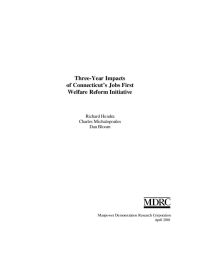Three-Year Impacts of Connecticut’s Jobs First Welfare Reform Initiative
This document was prepared as part of a large-scale evaluation of Connecticut's Jobs First welfare reform initiative. Implemented statewide in 1996, Jobs First includes a 21-month time limit on cash assistance receipt, generous financial work incentives, and other features. Its primary goal is to reduce welfare use and increase self-sufficiency through work. The Jobs First evaluation is being conducted by the Manpower Demonstration Research Corporation (MDRC), a nonprofit, nonpartisan organization, under a contract with the Connecticut Department of Social Services (DSS).
To facilitate the evaluation, between January 1996 and February 1997, several thousand welfare applicants and recipients in two DSS offices (Manchester and New Haven) were assigned, at random, to one of two groups: the Jobs First group, which is subject to the welfare reforms, or the Aid to Families with Dependent Children (AFDC) group, which is subject to the prior welfare rules. The two groups are being tracked over time, and any differences that emerge between them - for example, in employment rates or welfare payment amounts - can reliably be attributed to Jobs First because there were no systematic differences between the groups' members when they entered the study, and because both groups have experienced the same general economic and social conditions. Such differences are known as the program's effects or impacts.
In early 2000, MDRC completed a comprehensive interim report on Jobs First, including data on the program's implementation and estimates of its impacts on employment, public assistance receipt, income, and other outcomes, in the two years after people were assigned to the two groups. This report updates the impact estimates through three years of follow-up. Key findings include:
- Jobs First continues to have a positive impact on employment. The Jobs First group had higher employment rates and higher average earnings than the AFDC group in the first two years of the follow-up period, and this trend continued in Year 3. However, it appears that the program's impact on employment began to fade in Year 3, and its impact on average earnings disappeared by the end of that year.
- Jobs First generated substantial reductions in cash assistance receipt and payments in Year 3. Though Jobs First initially increased cash assistance payments due to its generous financial work incentive (a rule that allowed many people to retain their welfare grants after going to work), the pattern reversed when Jobs First group members began to reach the 21-month time limit near the end of the second year of follow-up. In Year 3, Jobs First reduced cash assistance receipt by 21 percent and reduced average cash assistance payments by 19 percent.
- The Jobs First and AFDC groups had about the same average income in Year 3 although, consistent with the program's goals, the Jobs First group derived a greater proportion of its income from earnings. Jobs First substantially raised family income in the period before people began reaching the time limit; the financial work incentive allowed many people to supplement their earnings with welfare grants. The pattern changed abruptly when people began reaching the time limit and, in Year 3, reductions in cash assistance and Food Stamps almost entirely offset increases in earnings, leaving the two groups with about the same income. In addition, a small group of families appeared to be losing income as a result of the program. However, it is important to note that the overall pattern of Year 3 results was consistent with the program's primary goal of increasing work and reducing reliance on welfare.
- The most impressive employment gains continue to be experienced by the most disadvantaged subgroup. In Year 3, Jobs First increased employment by 12 percentage points and earnings by 40 percent among those who entered Jobs First as long-term welfare recipients with no high school diploma and no recent work history. However, due to growing declines in AFDC/TFA benefits (presumably as the most disadvantaged sample members began to reach the time limit in larger numbers), early increases in total income for this subgroup disappeared in Year 3. In sharp contrast, sample members who were least disadvantaged seemed to experience little benefit from Jobs First.
- Only a small fraction of the Jobs First group received benefits continuously through the three years, and many of those who did worked while on welfare. Although many of the recipients who reach Jobs First's time limit are granted extensions, only about 6 percent of the Jobs First group received 35 or 36 countable months of cash assistance during the three-year study period (in other words, they received welfare more or less continuously and were not granted exemptions that stopped their time-limit clocks). When compared with other Jobs First group members, the continuous recipients were less likely to have a high school diploma, had longer histories of welfare receipt before entering Jobs First, and had more children. There were also much more likely to be African-American and to live in public or subsidized housing. Many of these individuals worked a substantial amount during the follow-up period, although their earnings were low. If this group is of concern, especially as the 60-month federal time limit approaches, DSS and its employment services partners will probably need to target them for special intensive services.
For the most part, the updated findings show a continuation of trends apparent at the end of the follow-up period for the interim report. However, more definitive evidence about the long term effects of Jobs First will have to wait for the final report, scheduled for late 2001. The final report will follow the groups for four years, present the results of a survey of about 2,400 Jobs First and AFDC group members, and examine Jobs First's impacts on the children of participants. Because there are still several critical open questions, and because the final report will be available relatively soon, it would seem prudent to delay making major changes in Jobs First until the final results of the study are known.






